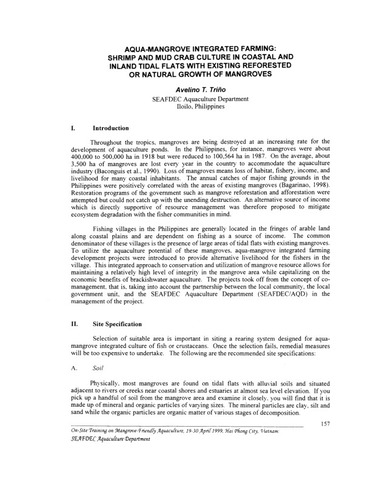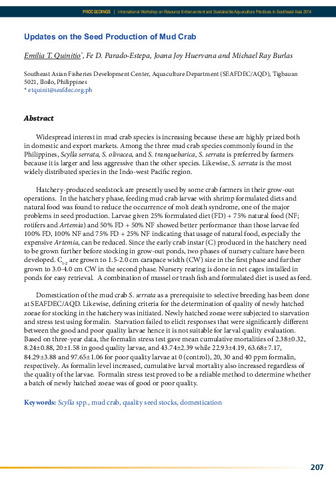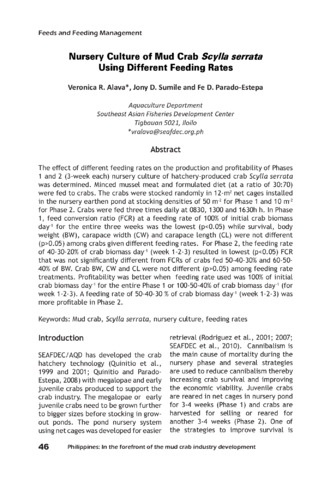Boosting the sustainability of aquaculture feed for the lucrative business of mangrove crab grow-out culture
| dc.contributor.author | Bautista-Teruel, Myrna N. | |
| dc.contributor.author | Licera, Rhiannen Marie C. | en |
| dc.date.accessioned | 2023-12-27T05:59:05Z | |
| dc.date.accessioned | 2024-01-02T07:55:52Z | |
| dc.date.available | 2023-12-27T05:59:05Z | |
| dc.date.available | 2024-01-02T07:55:52Z | |
| dc.date.issued | 2023-12 | |
| dc.identifier.uri | http://hdl.handle.net/20.500.12066/7430 | |
| dc.description.abstract | Conventional feeds for mangrove crab (Scylla serrata) are highly fixated on the use of fish-by-products (FBC) and other slaughter wastes. These feeds, however, are highly polluting that can easily cause water quality spoilage, and may affect the health of the mangrove crab. They can likewise bring about problems in supply shortage, reliability in quality, and as carriers of disease agents. In order to support the sustainability of the mangrove crab industry in Southeast Asia, there is a need to produce an efficient and viable aquaculture feed for this species. Although SEAFDEC has started venturing into researches with emphasis on crab feed development, it was deemed necessary to work on further improvement of feed formulation with the inclusion of ingredients that are less expensive based on published nutritional requirements and physical properties of mangrove crab. This study assessed the efficiency of the refined crab feed in land-based tanks. Refinement of this feed formulation focused on partial replacement of fishmeal with alternative ingredients such as mussel meat meal. Cholesterol was added to refined crab feed to improve molting processes affecting the growth of the animal (Coloso et al., 2017). The same diet was evaluated for its proximate composition, water stability, amino acid and fatty acid compositions, digestibility of nutrients, attractability and palatability, and its biological effects on cultured mangrove crabs. Overall, results indicated that refined crab feed can potentially be used as sole feed for the grow-out culture of crabs as it can enhance the animals’ growth and survival in tanks. | en |
| dc.language.iso | en | en |
| dc.publisher | Secretariat, Southeast Asian Fisheries Development Center | en |
| dc.subject | Scylla serrata | en |
| dc.subject | nutrition | en |
| dc.title | Boosting the sustainability of aquaculture feed for the lucrative business of mangrove crab grow-out culture | en |
| dc.type | magazineArticle | en |
| dc.citation.volume | 21 | en |
| dc.citation.issue | 2 | en |
| dc.citation.spage | 30 | en |
| dc.citation.epage | 34 | en |
| dc.citation.journalTitle | Fish for the People | en |
| dc.subject.asfa | aquaculture feeds | en |
| dc.subject.asfa | aquaculture | en |
| dc.subject.asfa | crab culture | en |
| dc.subject.asfa | feeds | en |
| dc.subject.asfa | sustainability | en |
| dc.subject.asfa | growth | en |
| dc.subject.asfa | survival | en |
| dc.subject.asfa | feeding experiments | en |
| dc.subject.asfa | feed composition | en |
| dc.subject.scientificName | Scylla serrata | en |
| local.subject | mangrove crab | en |
| local.subject | Scylla serrata | en |
| local.subject | nutrition | en |
| local.subject | grow-out culture | en |
Files in this item
| Files | Size | Format | View |
|---|---|---|---|
| Boosting-the-su ... ty-of-aquaculture-feed.pdf | 1.822Mb | application/pdf | View/ |
This item appears in the following Collection(s)
-
Fish for the People [41]
These articles were contributed by SEAFDEC/AQD staff to Fish for the People Magazine




